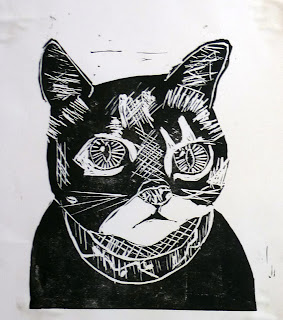Tomorrow is Harry Potter's birthday, the anniversary of Hagrid's dramatic arrival at a shack on an island to deliver to Harry his acceptance letter to Hogwarts School of Witchcraft and Wizardry. Harry's birthday introduced us in 1997 (1998 in the US) to the wizarding world according to J.K. Rowling, and also to some of the wizarding world's unique vocabulary. Rowling clearly enjoyed making up words for her magical universe, and the series's incredible popularity has brought many of those words into the mainstream. Here are a few of the most widely recognized.
 muggle - A Muggle is a non-magical person who's not part of the wizarding world. Most Muggles are completely unaware that magic even exists. This is the word that has gained the widest currency, taking on a life of its own and earning itself a place in dictionaries. Among some people it's used to mean someone without skill in a particular area, or someone outside the circle of a particular interest or activity. In this context it's often used pejoratively, or at least dismissively, unconsciously illustrating one of Rowling's primary themes: prejudice against outsiders. Those who disparage the people who don't share their interests or skills may soon be calling them mudbloods. (By the way, Rowling was sued over the word muggle by a woman who used it first, but I think this illustrates that it's easy enough for multiple people to independently come up with the same pleasing combinations of sounds. That's always a danger when you're trying to be creative. Rowling says her word derives from mug, a gullible person.)
muggle - A Muggle is a non-magical person who's not part of the wizarding world. Most Muggles are completely unaware that magic even exists. This is the word that has gained the widest currency, taking on a life of its own and earning itself a place in dictionaries. Among some people it's used to mean someone without skill in a particular area, or someone outside the circle of a particular interest or activity. In this context it's often used pejoratively, or at least dismissively, unconsciously illustrating one of Rowling's primary themes: prejudice against outsiders. Those who disparage the people who don't share their interests or skills may soon be calling them mudbloods. (By the way, Rowling was sued over the word muggle by a woman who used it first, but I think this illustrates that it's easy enough for multiple people to independently come up with the same pleasing combinations of sounds. That's always a danger when you're trying to be creative. Rowling says her word derives from mug, a gullible person.)
quidditch - The wizarding world's favorite sport, quidditch is played on broomsticks and uses four balls: a quaffle, two bludgers, and the golden snitch. Some Muggles have devised a terrestrial and non-magical game they call quidditch, and a number of colleges now have so-called quidditch teams. But I say, if you can't play on a broomstick, what's the point?
dementor - Dementors are horrible dark creatures who feed on happiness and, if given the chance, will suck out a person's soul. They were used as guards at the wizard prison Azkaban, until the Ministry of Magic lost control of them. It's good to be aware of them because even though they're invisible to Muggles, we can still feel their miserable and demoralizing influence. Sometimes life feels as if all the happiness is getting sucked out, and then you know to hold on to your soul because a dementor is near. The best antidote to dementor depression is chocolate.
expelliarmus - I picked this as an example of a Hogwarts-style magical spell. I don't know whether any particular one of the spells from Harry Potter is the most commonly recognized, but I've certainly heard a few here and there. One of my favorites, expelliarmus is a combination of the Latin expellere, meaning ‘to drive or force out’, and arma, meaning weapon. It's the disarming spell, and illustrates Rowling's copious use of Latin for magical words.
animagus - Wizards who can take the form of an animal, animagi are quite rare. As a word I think this one has a particular genius. It seems so obvious that it's hard to believe the word doesn't date back to the middle ages. You might think the more abstruse or complicated words would show more creativity, but often it's much harder to make up a new word that seems completely natural and unforced.
horcrux - In contrast to animagus, the roots of horcrux are not obvious. Nevertheless, it shows Rowling's talent for coinage because it really seems like it could have been a real word from alchemy or occult magic. A horcrux is an object in which a wizard has hidden a part of his soul, but since the wizard must commit an atrocity in order to break off the piece of his soul in the first place, it's always a dark and evil thing. Rowling's word captures the feel of dark, mysterious, arcane magic well.
Don't forget that even Muggles can celebrate Harry's birthday with some well-chosen magical words - after all, it's J.K. Rowling's birthday, too.
[Pictures: "The Quidditch World Cup," chapter heading drawing by Mary GrandPré from Harry Potter and the Goblet of Fire, 2000;
"The Dementor," chapter heading drawing by GrandPré from Harry Potter and the Prisoner of Azkaban, 1999.]


























